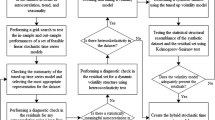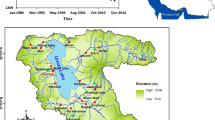Abstract
The decline in Lake Urmia (LU) water level during the past two decades has been addressed by several studies. However, the conducted studies could not come across a practical solution by considering the sample mean in the lake water level time series. For this, the present study suggests a fresh look to the lake water level decline in LU by addressing the volatility changes instead. The Bayesian change-point detection method was used to define the major and critical change points during the study period from January 1966 to December 2016 on a daily scale. Results indicated that major changes occurred in early 2000, and the time series can be studied under the pre- and post-change point events. Afterward, several methods namely shift-track and mono- and multiple-trend line analyses were used to remove the trends associated with the lake water level time series. The de-trending approaches later were applied separately for the entire study period, before 2000 (i.e., 1966–1999) and afterward (i.e., 2000–2016). Then, the de-trended time series were used, and a generalized autoregressive conditional heteroscedasticity (GARCH) model was fitted to the de-trended time series to predict the volatility changes in the data run. Results indicated to descending and ascending changes, respectively, in short- and long-term persistence after 2000. The GARCH(1,1) model was found to be satisfactory to interpret the pre- and post-turn point events, while the changes in short- and the long-term persistence were calculated as 0.53 to 0.75 and 0.46 to 0.24, respectively. In addition, by considering the lake water level anomaly and coefficient of variation in LU and two neighboring cases of Lake Sevan and Lake Van, it is concluded that the changes are exclusive to LU, and the rate of changes was accelerated after 2006.





Similar content being viewed by others
References
Ashraf B, Agha Kouchak A, Alizadeh A, Baygi MM, Moftakhari HR, Mirchi A, Anjileli H, Madani K (2017) Quantifying anthropogenic stress on groundwater resources. Sci Rep 7(1):12910
Balkanlou KR, Müller B, Cord AF, Panahi F, Malekian A, Jafari M, Egli L (2020) Spatiotemporal dynamics of ecosystem services provision in a degraded ecosystem: a systematic assessment in the Lake Urmia basin, Iran. Sci Total Environ 716:137100
Bollerslev T (1986) Generalized autoregressive conditional heteroscedasticity. J Econ 31:307–327
Brock WA, Dechert WD, Scheinkman JA, LeBaron B (1996) A test for independence based on the correlation dimension. Econ Rev 15:197–235
Crétaux JF, Jelinski W, Calmant S, Kouraev A, Vuglinski V, Bergé Nguyen M, Gennero MC, Nino F, Abarca Del Rio R, Cazenave A, Maisongrande P (2011) SOLS: a lake database to monitor in the near real time water level and storage variations from remote sensing data. Adv Space Res 47(9):1497–1507
Danesh-Yazdi M, Ataie-Ashtiani B (2019) Lake Urmia crisis and restoration plan: planning without appropriate data and model is gambling. J Hydrol 576:639–651
Dickey DA, Fuller WA (1979) Distribution of the estimators for autoregressive time series with a unit root. J Am Stat Assoc 74:423–431
Farzin S, Ifaei P, Farzin N, Hassanzadeh Y, Aalami MT (2012) An investigation on changes and prediction of Urmia Lake water surface evaporation by chaos theory. Int J Environ Res 6(3):815–824
Farzin S, Hajiabadi R, Ahmadi MH (2017) Application of Chaos theory and artificial neural networks to evaluate evaporation from lake’s water surface. J Water Soi 31(1):61–74
Fathian F (2019) Dynamic memory of Urmia Lake water-level fluctuations in hydroclimatic variables. Theor Appl Climatol 138(1–2):591–603
Fathian F, Dehghan Z, Eslamian S (2014) Analysis of water level changes in Lake Urmia based on data characteristics and non–parametric test. Int J Hydro Sci Technol 4(1):18–38
Fathian F, Modarres R, Dehghan Z (2016b) Urmia lake water level change detection and modeling. Model Earth Syst Environ 2(4):1–16
Fathian F, Morid S, Kahya E (2015) Identification of trends in hydrological and climatic variables in Urmia Lake basin, Iran. Theor Appl Climatol 119(3–4):443–464
Fathian F, Dehghan Z, Bazrkar MH, Eslamian S (2016a) Trends in hydrological and climatic variables affected by four variations of the Mann-Kendall approach in Urmia Lake basin, Iran. Hydrol Sci J 61(5):892–904
Fathian F, Fakheri-Fard A, Modarres R, van Gelder PHAJM (2018) Regional scale rainfall–runoff modeling using VARX–MGARCH approach. Stoch Env Res Risk A 32(4):999–1016
Fathian F, Fakheri-Fard A, Ouarda TBMJ, Dinpashoh Y, Nadoushani SSM (2019a) Multiple streamflow time series modeling using VAR–MGARCH approach. Stoch Env Res Risk A 33(2):407–425
Fathian F, Fakheri-Fard AF, Ouarda TBMJ, Dinpashoh Y, Nadoushani SM (2019b) Modeling streamflow time series using nonlinear SETAR-GARCH models. J Hydrol 573:82–97
Ghorbanalizadeh A, Akhani H, Bergmeier E (2020) Vegetation patterns of a rapidly drying up salt Lake ecosystem: Lake Urmia, NW Iran. Phytocoenologia 50:1–46. https://doi.org/10.1127/phyto/2019/0338
Hassanzadeh E, Zarghami M, Hassanzadeh Y (2012) Determining the main factors in declining the Urmia Lake level by using system dynamics modeling. Water Resour Manag 26:129–145
Hosseini-Moghari SM, Araghinejad S, Tourian MJ, Ebrahimi K, Döll P (2020) Quantifying the impacts of human water use and climate variations on recent drying of Lake Urmia basin: the value of different sets of spaceborne and in situ data for calibrating a hydrological model. Hydrol Earth Syst Sci Discuss 24(4):1939–1956
Jeihouni M, Toomanian A, Alavipanah SK, Hamzeh S (2017) Quantitative assessment of Urmia Lake water using spaceborne multisensor data and 3D modeling. Environ Monit Assess 189(11):572
Kakahaji H, Banadaki HD, Kakahaji A, Kakahaji A (2013) Prediction of Urmia Lake water-level fluctuations by using analytical, linear statistic and intelligent methods. Water Resour Manag 27(13):4469–4492
Khazaei B, Khatami S, Alemohammad SH, Rashidi L, Wu C, Madani K, Aghakouchak A (2019) Climatic or regionally induced by humans? Tracing hydro-climatic and land-use changes to better understand the Lake Urmia tragedy. J Hydrol 569:203–217
Khatami S (2013) Nonlinear chaotic and trend analyses of water level at Urmia Lake, Iran. M.Sc. Thesis report: TVVR 13/5012, ISSN: 1101–9824, Lund University, Lund, Sweden
Levene H (1960) Robust tests for equality of variances1. Contributions to probability and statistics: Essays in honor of Harold Hotelling 2: 278–292
Modarres R, Ouarda TBMJ (2012a) Generalized autoregressive conditional heteroscedasticity modeling of hydrologic time series. Hydrol Process 27(22):3174–3191
Modarres R, Ouarda TBMJ (2012b) Modeling heteroscedasticity of streamflow time series. Hydrol Sci J 58(1):54–64
Modarres R, Ouarda TBMJ (2014a) Modeling the relationship between climate oscillations and drought by a multivariate GARCH model. Water Resour Res 50(1):601–618
Modarres R, Ouarda TBMJ (2014b) A generalized conditional heteroscedastic model for temperature downscaling. Clim Dyn 43(9–10):2629–2649
Noury M, Sedghi H, Babazedeh H, Fahmi H (2014) Urmia lake water level fluctuation hydro informatics modeling using support vector machine and conjunction of wavelet and neural network. Water Res 41(3):261–269
Ouarda TBMJ, Charron C, Niranjan Kumar K, Marpu P, Ghedira H, Molini A, Khayal I (2014) Evolution of rainfall regime in the UAE. J Hydrol 514:258–270
Pengra B (2012) The drying of Iran's Lake Urmia and its environmental consequences. UNEPGRID, Sioux Falls, UNEP global environmental alert service (GEAS). Environ Dev 2:128–137
Rezaei A, Gurdak JJ (2020) Large-scale climate variability controls on climate, vegetation coverage, lake and groundwater storage in the Lake Urmia watershed using SSA and wavelet analysis. Sci Total Environ 724:138273
Seidou O, Ouarda TBMJ (2007) Recursion-based multiple change point detection in multivariate linear regression and application to river streamflows. Water Resour Res 43:W07404
Seidou O, Asselin JJ, Ouarda TBMJ (2007) Bayesian multivariate linear regression with application to change point models in hydrometeorological variables. Water Resour Res 43:W08401
Vaheddoost B, Aksoy H (2019) Reconstruction of hydrometeorological data in Lake Urmia basin by frequency domain analysis using additive decomposition. Water Resour Manag 33(11):3899–3911
Vaheddoost B, Aksoy H (2018) Interaction of groundwater with Lake Urmia in Iran. Hydrol Process 32(21):3283–3295
Vaheddoost B, Aksoy H, Abghari H (2016) Prediction of water level using monthly lagged data in Lake Urmia, Iran. Water Resour Manag 30(13):4951–4967
Vaheddoost B, Aksoy H (2017) Structural characteristics of annual precipitation in Lake Urmia basin. Theor Applied Climatol 128(3–4):919–932
Vaheddoost B, Kocak K (2019) Temporal dynamics of monthly evaporation in Lake Urmia. Theor Applied Climatol 137(3–4):2451–2462
Wang W, Vrijling JK, Van Gelder PH, Ma J (2006) Testing for nonlinearity of streamflow processes at different timescales. J Hydrol 322(1):247–268
Acknowledgments
The authors would like to thank the Editorial board and two anonymous reviewers for their fruitful comments. The authors also appreciate the support of the Hydro Web service in providing the data related to the GRACE satellite for Lake Urmia, Lake Van, and Lake Sevan, as well as the Vali-e-Asr University of Rafsanjan for providing the Lake Urmia time series data.
Author information
Authors and Affiliations
Corresponding author
Additional information
Publisher’s note
Springer Nature remains neutral with regard to jurisdictional claims in published maps and institutional affiliations.
Rights and permissions
About this article
Cite this article
Fathian, F., Vaheddoost, B. Modeling the volatility changes in Lake Urmia water level time series. Theor Appl Climatol 143, 61–72 (2021). https://doi.org/10.1007/s00704-020-03417-8
Received:
Accepted:
Published:
Issue Date:
DOI: https://doi.org/10.1007/s00704-020-03417-8




